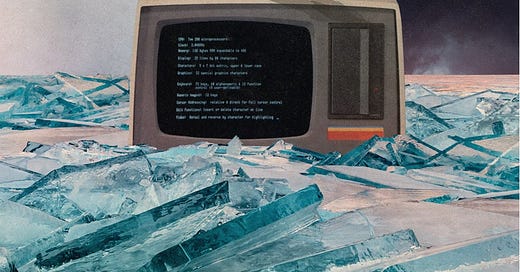This entry is part of a series on “The Pull”: Preface. The Pull. Intro. Overcome The Pull. 1. The Road. 2. The Fronts. 3. The Tools. 4. The Practice. Conclusion. Beyond The Pull.
The Pull is the subtle, unconscious force that draws you into the screen. I am writing this series as a practical guide to overcoming it for good—before it’s too late. In this entry, I’ll discuss the high-level roadmap needed.
The best Substacks for developing a good relationship with The Pull is
and by and . While they do not use the phrase, they provide a wealth of resources on overcoming The Pull. Their “3Rs of Unmachining” roadmap is the one I recommend. It consists of the following guideposts:Recognize
Remove
Return
Recognize is about understanding how bad things are—and how bad they can become—with the direction technology is heading. Most people reading this Substack will not need a detailed introduction to the litany of problematic aspects of technology. I have been using the following dialectic, which seems to help with the Recognize phase for those who are philosophically minded:
Techno-optimism: Technology is good and will save humanity.
Techno-pessimism: Technology is bad and will destroy humanity.
Techno-realism: Technology can be good or bad, and it is incumbent upon us to develop a wise relationship with it.
Most at the helm of tech’s development are optimists, most intellectuals are pessimists, and both mistakenly think of themselves as realists. However, to truly embody the realist position, one must first go through a pessimist’s rite of passage—recognizing the hellish futures that an unconscious relationship with technology can bring.
The Gaskovskis’ Substacks, documentaries such as The Social Dilemma, and the Unabomber manifesto all help promote techno-pessimism. I view this conscious approach to pessimism as similar to what philosopher Jean-Pierre Dupuy calls “enlightened doomsaying”—truly believing that catastrophe could happen, as if it already has, which moves one to do what they can to prevent it.
Once this enlightened doomsaying occurs, one can move to the Remove phase. Yet, one must be deliberate in what they remove. It is a foolish quest to remove technology outright from one’s life. It is tricky to determine what the actual problem is. Is it smartphones, social media, email, messengers, or the internet altogether?
As many lives are reliant on these things, I advocate focusing on removing The Pull. Once it is removed, things fall into place, and a wise relationship with screen-related technology naturally follows. In essence, it is the highest-leverage move.
This series primarily focuses on the Remove guidepost and will offer practical suggestions for removing The Pull. However, once it is removed, it is important to have a north star, or else the risk of being recaptured remains.
The Return offers a north star: communing with real people—family, friends, and intentional communities—off the screen. The Return is the most difficult phase due to the “problem of terrible communities.”
In my series on terrible communities, I argue that most in-person “communities” (if we can even call them that) are terrible—filled with fakeness, petite sociopaths, chronic feelings of being unseen, and weirdly enmeshed dynamics that can feel cult-like. The reason people become “extremely online” in the first place, falling prey to The Pull, is to escape the terrible communities they are physically embedded in.
As the “Rat Park” video below discusses, addiction is not purely due to chemical dependency but also to a lack of connection with others.
It traces an experiment by psychologist Bruce Alexander in the 1970s, showing that rats in socially isolated environments—who had access to both morphine-laced water and regular water—drank the laced water until they died. However, when Alexander created a “rat park”—a paradise full of other rats to play and mate with—they rarely used the morphine-laced water.
Those called to Return might not have anything inspiring to return to. Being embedded in a terrible community with an internet connection is like being a rat stuck in an isolated cage with morphine-laced water readily available. The pull the rats feel toward the morphine is the same one people feel toward their screens.
To return, one must have the courage to confront their terrible community and aspire to make it less terrible. Start with your partner or family. It is tragic for couples and families—especially those who live together—to feel alienated from one another, spending more quality time on their screens than with each other.
If this hurdle feels too big, or if one does not have a significant other or family nearby, I suggest starting with God.
If you have any questions, insights, feedback, or criticism on this entry or more generally, message me below (I read and respond on Saturdays) …




